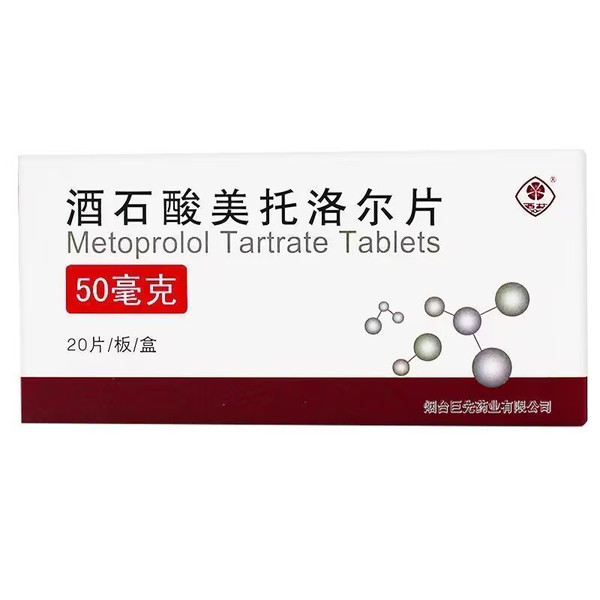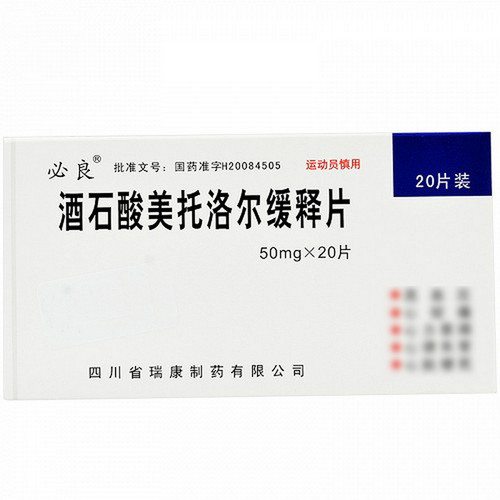Product Overview
[Drug Name]
Generic Name: Metoprolol Tartrate Tablets
Trade Name: Xiyuan Metoprolol Tartrate Tablets 50mg*20 Tablets
Pinyin Code: XiYuan JiuShiSuanMeiTuoLuoErPian 50mg*20 Tablets
[Main Ingredients]
The main ingredient of this product is metoprolol tartrate.
[Properties]
This product is a white tablet.
[Indications/Main Functions]
It is used to treat hypertension, angina pectoris, myocardial infarction, hypertrophic cardiomyopathy, aortic dissection, arrhythmias, hyperthyroidism, and cardiac neurosis. In recent years, it has also been used to treat heart failure. In this case, it should be used under the guidance of an experienced physician.
[Precautions]
1. Propranolol can delay the recovery of blood sugar levels after insulin administration, but this adverse effect is less common with selective beta-blockers. Patients with diabetes who are taking insulin should be aware that the beta-blocker effect can mask hypoglycemia symptoms, such as palpitations, and thus delay timely detection. However, the risk of selective beta-blockers interfering with glucose metabolism or masking hypoglycemia during treatment is lower than with non-selective beta-blockers. 2. If long-term treatment with this drug is interrupted, the dose should be gradually reduced, generally within 7-10 days, with at least 3 days to wait. Abrupt discontinuation of this drug, especially in patients with coronary artery disease, can worsen the condition, leading to angina, myocardial infarction, or ventricular tachycardia. 3. There is disagreement regarding whether to discontinue beta-blockers before major surgery. Beta-blockade reduces the heart's response to reflex sympathetic stimulation, increasing the risks of general anesthesia and surgery, but this can be reversed with dobutamine or isoproterenol. Nevertheless, it is best to discontinue this drug in patients undergoing general anesthesia, if possible 48 hours before anesthesia. 4. Beta-blockers should be used prior to treatment for pheochromocytoma. 5. Use with caution in patients with hypotension, heart, or hepatic insufficiency. 6. Patients with chronic obstructive pulmonary disease and bronchial asthma should also use metoprolol with caution, preferably in low doses.
[Drug Interactions]
Cardiogenic shock. Sick sinus syndrome. Second- and third-degree atrioventricular block. Patients with unstable, decompensated heart failure (pulmonary edema, hypoperfusion, or hypotension), patients receiving continuous or intermittent inotropic therapy with agonists. Symptomatic bradycardia or hypotension. This product should not be used in patients with suspected acute myocardial infarction with a heart rate <45 beats/min, a P-Q interval >0.24 seconds, or a systolic blood pressure <100 mmHg. Patients with severe peripheral vascular disease with a risk of gangrene. Patients with hypersensitivity to any component of this product or other agonists.
[Pediatric Use]
There is limited experience with this product in children.
[Use in Elderly Patients]
The pharmacokinetics of β-blockers in the elderly do not differ significantly from those in younger patients, so no dosage adjustment is required.
[Use in Pregnant and Lactating Women]
The use of β-blockers during pregnancy can cause various fetal problems, including fetal growth retardation. β-blockers can have adverse effects on the fetus and neonate, particularly bradycardia, and therefore should not be used during pregnancy or delivery.
[Specifications]
50mg x 20 tablets (Xiyuan)
[Dosage and Administration]
Oral administration: For the treatment of hypertension, take 100-200mg once, divided into 1-2 doses. For acute myocardial infarction: Early use, within the first few hours, is recommended because immediate use can reduce infarct size and short-term (15-day) mortality in patients who have not achieved thrombolysis (this effect is evident 24 hours after administration). In patients who have already achieved thrombolysis, it can reduce the rate of reinfarction and re-ischemia, and can even reduce mortality if administered within 2 hours. Generally, metoprolol is administered intravenously as a single dose of 2.5-5 mg (within 2 minutes), administered every 5 minutes for three doses, for a total dose of 10-15 mg. 15 minutes later, 25-50 mg should be taken orally every 6-12 hours for 24-48 hours, followed by 50-100 mg twice daily. Early use is also recommended for unstable angina, with the same dosage and administration as for acute myocardial infarction. Intravenous metoprolol can be used in the setting of atrial fibrillation during acute myocardial infarction, provided there are no contraindications. Long-term use after a myocardial infarction is recommended, as it has been shown to reduce cardiac mortality, including sudden death. The typical dosage is 50-100 mg twice daily. For the treatment of hypertension, angina, arrhythmias, hypertrophic cardiomyopathy, and hyperthyroidism, the typical dosage is 25-50 mg two to three times daily, or 100 mg twice daily. Heart Failure: This drug should be used in addition to anti-heart failure treatment with digitalis and/or diuretics.
[Adverse Reactions]
1. Cardiovascular System: Decreased heart rate, conduction block, hypotension, worsening heart failure, peripheral vasospasm leading to cold extremities or loss of pulse, and Raynaud's phenomenon. 2. Due to its lipid solubility and easy penetration into the central nervous system, this system has more adverse reactions. Fatigue and dizziness account for 10%, depression for 5%, and other adverse reactions include headache, nightmares, and insomnia. Hallucinations may occur occasionally. 3. Digestive System: Nausea, stomach pain, constipation (<1%), and diarrhea (5%), but these are not serious and rarely affect medication use. 4. Other: Dyspnea, joint pain, itching, retroperitoneal fibrosis, deafness, and eye pain.
[Contraindications]
Cardiogenic shock. Sick sinus syndrome. Second- and third-degree atrioventricular block. Patients with unstable, decompensated heart failure (pulmonary edema, hypoperfusion, or hypotension), patients receiving continuous or intermittent inotropic therapy with beta-blockers, and patients with symptomatic bradycardia or hypotension. This drug should not be administered to patients with suspected acute myocardial infarction and a heart rate <45 beats/min, a P-Q interval >0.24 seconds, or a systolic blood pressure <100 mmHg. Patients with severe peripheral vascular disease with a risk of gangrene. Patients with hypersensitivity to any component of this drug or other beta-blockers.
[Overdose]
Unknown.
[Pharmacology and Toxicology]
This drug is a Class 2A beta-blocker without partial agonist activity (cardioselective beta-blocker). It selectively blocks beta-1 receptors, lacks PAA (partial agonist activity), and has no membrane stabilizing effects. Its beta-blocking activity is approximately equivalent to that of propranolol (PP) and slightly less selective for beta-1 receptors than atenolol. Metoprolol's cardiac effects, such as slowing heart rate, inhibiting cardiac contractility, reducing automaticity, and delaying atrioventricular conduction time, are similar to those of propranolol and atenolol (AT). Its ability to reduce elevated blood pressure and heart rate during exercise testing is also similar to that of PP and AT. Its contractile effect on vascular and bronchial smooth muscle is weaker than that of PP, resulting in less respiratory effects, but still more potent than that of AT.
[Pharmacokinetics]
This drug is completely absorbed orally and undergoes extensive first-pass metabolism, with a bioavailability of approximately 20%. Peak plasma concentrations occur 2.5-5 hours after dosing. Peak plasma concentrations and the area under the concentration-time curve (AUC) increase linearly with dose within the 20 mg range. This drug is >99% bound to plasma proteins. Following a 10 mg oral dose of this drug in young, healthy subjects, mean peak and trough steady-state plasma concentrations were 7 nmol/L and 2 nmol/L, respectively. Following an oral dose of 20 mg of levofloxacin, mean peak-trough steady-state plasma concentrations were 23 nmol/L and 7 nmol/L, respectively, in hypertensive patients (mean age 64 years). Since the median effective concentration of levofloxacin is 4-6 nmol/L, oral doses of 5-10 mg or 20 mg are expected to achieve a 24-hour antihypertensive effect, depending on the patient. In young, healthy subjects, systemic plasma clearance of levofloxacin is approximately 0.8 L/min, and the apparent volume of distribution is approximately 10 L/kg. Levofloxacin plasma concentrations increase with age. The mean clearance in elderly hypertensive patients (mean age 74 years) is only 45% of that in younger patients (mean age 26 years), and the steady-state AUC in younger patients is only 39% of that in older patients. Levofloxacin bioavailability is affected by diet. When administered with a high-fat or carbohydrate meal, Cmax increases by 60%, while AUC remains unchanged. A small, bland meal (orange juice, toast, and cereal) does not affect the pharmacokinetic profile of levofloxacin. The bioavailability of this drug increases approximately 2-fold when consumed with grapefruit juice. Orange juice has not been observed to alter the drug's kinetics. In hypertensive patients taking this drug, the average peak plasma concentration at steady state is 20% higher than after a single dose. The antihypertensive effect is correlated with the plasma concentration of felodipine. The clearance of this drug in patients with hepatic impairment is 60% of that in normal young subjects. Renal insufficiency does not alter the drug's plasma concentration profile, but the concentration of its inactive metabolite in plasma increases due to decreased urinary excretion. Animal studies have shown that this drug can cross the blood-cerebrospinal fluid barrier and the placenta.






